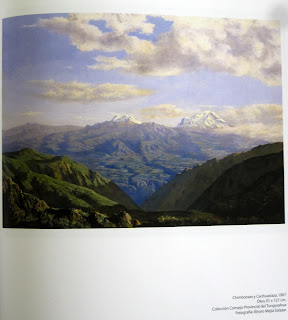Martinez was a mountain climber, which gave a lot of realism to his art. But his paintings were definitely romantic - you can see a lot of inferences to the presence of God in his work. The sky in many of his paintings take up a third to half of the piece. And there's a lot of golden, heavenly light in there, too.
Another thing he was really good at was working in a play of light and shadow to create depth and add distance to his pieces.
He saw his work as a scientific document - he was not just painting a pretty picture, but more importantly, showing everyone what these mostly unseen landscapes looked like.
 |
| El Altar in the early 1900s |
 |
| View of El Altar in 2008, taken by Ivan Layedra P |
I think his work really conveys the feeling that one gets in the solitude of nature and in the presence of something greater than ourselves. These mountains and landscapes will outlast all of us.
[Paintings from the book "Luis A. Martinez" by Fernando Jurado Noboa]




No comments:
Post a Comment